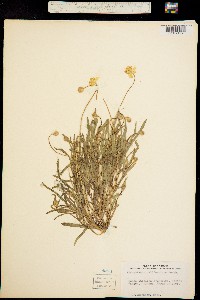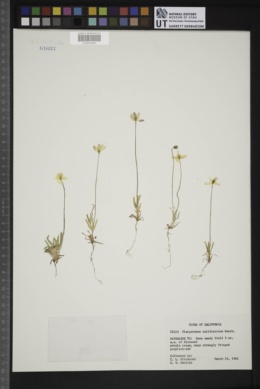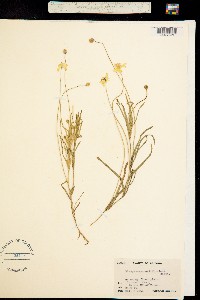Platystemon californicus
|
|
|
|
Family: Papaveraceae
California Creamcups, more...creamcups, cream cups
[Platystemon arizonicus Greene, morePlatystemon arvorum Greene, Platystemon californicus var. californicus , Platystemon californicus var. ciliatus Dunkle, Platystemon californicus var. crinitus Greene, Platystemon californicus var. horridulus (Greene) Jepson, Platystemon californicus var. nutans Brandeg., Platystemon californicus var. ornithopus (Greene) Munz, Platystemon confinis Greene, Platystemon mohavensis Greene, Platystemon purpuratus Greene, Platystemon remotus Greene] |
Plants 0.3-3 dm, pilose or hirsute, sometimes glabrate. Leaves 10-90 × 1.7-8.1 mm; blade broadly linear; margins entire; apex rounded to long-acute. Inflorescences: peduncle 3.4-25.8 cm; bud globose to ovoid-cylindric. Flowers: petals white to cream colored, sometimes with yellow tip and/or base, rarely gold overall, sometimes tinged red in age, narrowly ovate to obovate, 6-19 × 3.5-16 mm, apex acute to rounded; ovary cylindric to oblong-ellipsoid; stigmas linear, margin revolute. Capsules ellipsoid, to 1.6 cm. Seeds black, shining, smooth. 2 n = 12 (plus occasional supernumerary chromosomes). Flowering early-late spring. Open, grassy areas with loose or disturbed soil or following burns; 0-1000(-2000) m; Ariz., Calif., Nev., Oreg., Utah; Mexico (Baja California). This highly variable, wind-pollinated taxon has been split into as many as 57 species on the basis of characteristics showing little cohesiveness. Ecotypic variation has produced morphologic extremes ranging from semisucculent, nearly glabrous coastal forms to very robust, moderately pubescent plants of interior grassland to compact, densely pubescent plants of semidesert habitats (G. L. Hannan 1979, 1982). Several varieties are recognized in some currently used floras: Platystemon californicus var. ciliatus Dunkle, from Santa Barbara Island; P . californicus var. nutans M. Brandegee, from coastal San Diego County and Santa Rosa and Santa Cruz islands; and P . californicus var. ornithopus (Greene) Munz, from San Miguel, San Nicholas, and Santa Rosa islands. These geographically restricted morphotypes appear to result from the same sort of ecotypic variation found in many other parts of the range. Rather than naming each ecotype, it seems best to treat Platystemon as a single, highly variable species with many locally adapted, intergrading populations.
Plant: annual herb; mainly 1-2.5 dm tall, many stemmed, sparsely to moderately covered with long, spreading, soft hairs; sap colorless Leaves: opposite, whorled, mainly basal or near the stem base, entire, 1.2-5 cm long, linear, sessile or subsessile Flowers: solitary; peduncles mainly 10-20 cm long; sepals 6-10 mm long, pilose, the hairs 1-2.5 mm long; petals 6, cream (fading yellow), distinct, deciduous, elliptic, 8-12 mm long or longer; stamens many; filaments flattened; anthers linear; ovary of 6 or more united carpels, these separate in fruit Fruit: FRUITS moniliform, 10-20 mm long, linear, beaked, constricted between each of several seeds, breaking at maturity into 1-seeded, indehiscent segments; SEEDS 1 mm long, elliptic to reniform, brown, wrinkled, moderately shiny Misc: Sonoran and other warm desert scrub, desert grassland, and chaparral communities, including both dry upland sites and riparian areas, especially on damp streambanks. Often appearing after a burn; 550-1350 m (1800-4500 ft); Mar-May Notes: beaked and splitting into one seeded units.Leaf surface is soft-pilose.Flower sepals are somewhat hairy References: Ownbey, Gerald B., Jeffrey W. Brasher, and Curtis Clark. 1998 Papaveraceae. J. Ariz. - Nev. Acad. Sci. 30(2): 120. Kearney & Peebles; Arizona Flora. McDougall; Seed plants of Northern Arizona. Hickman, ed.; The Jepson Manual. ASU specimans Ownbey et al. 1998, FNA 2006 Duration: Annual Nativity: Native Lifeform: Forb/Herb General: Annual, subscapose herb, mainly 3-30 cm tall, sparsely to moderately covered with long, spreading, soft hairs; sap colorless. Leaves: Opposite, whorled, mainly basal or near stem base, entire, 1.2-5 cm long, linear, sessile or subsessile. Flowers: Solitary on peduncles 10-20 cm long, sepals 6-10 mm long, pilose, hairs 1-2.5 mm long; petals 6, cream to white, fading yellow in some, distinct, deciduous, elliptic, 8-12 mm long or longer; stamens many, filaments flattened, linear anthers, ovary of 6 or more united carpels, these separate in fruit. Fruits: Ellipsoid capsule to 1.6 cm, constricted between each of several seeds, breaking at maturity into 1-seeded, indehiscent segments. Ecology: Found in open areas, often in loose or disturbed soils from 1,500-4,500 ft (457-1372 m); flowers March-May. Notes: This species is highly variable taxon, having been subdivided into as many as 57 species at one point in time. Best considered as a single, highly variable species with many locally adapted, intergrading populations. (FNA) Also known to appear after burns. Ethnobotany: The leaves were eaten as greens. Etymology: Platystemon comes from Greek platus, broad and stemon, stamens, referring to the flattened stalks of the stamens, while californicus means of or from California. Synonyms: Many, see Tropicos Editor: SBuckley, 2010 |
|
|
|




































































